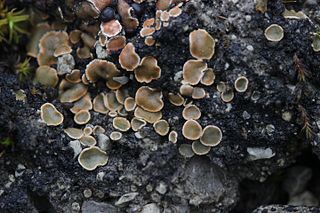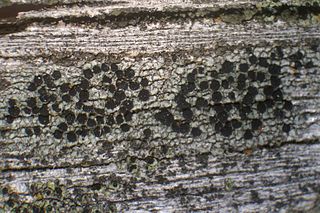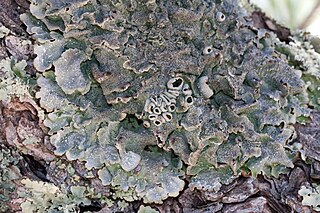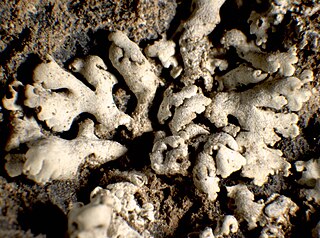
Psora is a genus of lichen-forming fungi in the family Psoraceae. Members of the genus are commonly called fishscale lichens. Lichens in the genus Psora generally have a squamulose thallus and anthraquinones in the hymenium. Photobiont partners of Psora lichens include members of the green algal genera Asterochloris, Chloroidium, Myrmecia, and Trebouxia.

Buellia is a genus of mostly lichen-forming fungi in the family Caliciaceae. The fungi are usually part of a crustose lichen. In this case, the lichen species is given the same name as the fungus. But members may also grow as parasites on lichens (lichenicolous). The algae in the lichen is always a member of the genus Trebouxia.

Phaeophyscia is a genus of lichen-forming fungi in the family Physciaceae.

Punctelia hypoleucites, commonly known as the southwestern speckled shield lichen, is a species of foliose (leafy) lichen in the family Parmeliaceae. First formally described by Finnish botanist William Nylander as a species of Parmelia, it was transferred to the genus Punctelia in 1982. The lichen is found in Africa, North America, and South America, where it grows on the bark of both hardwood and coniferous trees. Its greenish-grey thallus is covered with tiny white pseudocyphellae – minute holes in the thallus surface that facilitate gas exchange. Some macroscopic features that help distinguish this species from other related members of the genus include the presence and the structure of the apothecia, the absence of asexual surface propagules, and the light brown color of the thallus undersurface. Chemically, the presence of lecanoric acid in the medulla and atranorin in the cortex help distinguish it from lookalikes.
Asterothyrium vezdae is a species of foliicolous (leaf-dwelling) lichen in the family Gomphillaceae. It is found in Bolivia, where it grows on the leaves of vascular plants in the Amazon rainforest. The lichen is distinguished from its closest relative, Asterothyrium octomerum, by the larger number of septa in its ascospores, and its and black apothecia.

Placomaronea candelarioides is a species of saxicolous (rock-dwelling), foliose lichen in the family Candelariaceae. It is found in South America. This lichen species can be recognised by its distinct umbilicate, monophyllous growth form.
Placomaronea fuegiana is a species of saxicolous (rock-dwelling), crustose lichen in the family Candelariaceae. Found in South America, it was formally described as a new species in 2009 by Martin Westberg and Patrik Frödén. The type specimen was collected by the second author in Tierra del Fuego, Argentina, where it was found growing on sandstone. The species epithet fuegiana refers to the type locality. It also occurs in Pali-Aike National Park, where it grows in the pits of volcanic rocks.
Placomaronea kaernefeltii is a rare species of saxicolous (rock-dwelling) lichen in the family Candelariaceae. Found in South America, it was formally described as a new species in 2009 by lichenologists Martin Westberg, Patrik Frödén, and Mats Wedin. The type specimen was collected by the second author from Arica (Chile), between Socoroma and Putre, at an altitude of 3,750 m (12,300 ft), where it was found growing along cracks and pits on a siliceous boulder in a dry mountain slope. The lichen is only known to occur at its type locality, although the authors suggest a wider distribution is likely. The species epithet honours Swedish lichenologist Ingvar Kärnefelt.
Lecidea lygommella is a species of saxicolous (rock-dwelling), crustose lichen in the family Lecideaceae. It spreads up to 7 cm wide with a thin thallus varying in colour from whitish and pale grey to rusty red-brown, featuring areolate surfaces with irregularly shaped areoles. Its fruiting bodies range from slightly embedded to sitting atop the thallus and black, flat to slightly convex apothecial discs. Unlike its lookalike Lecidea lygomma, L. lygommella does not produce any secondary chemicals. It is found in New South Wales and Victoria, Australia, where it grows on rocks in alpine areas.
Menegazzia endocrocea is a species of foliose lichen in the family Parmeliaceae. It is found in Australia. The lichen forms irregular rosettes up to 10 cm wide with hollow, cylindrical lobes that branch dichotomously, featuring a pale grey to cream-grey upper surface with roundish holes and a wrinkled, black lower surface. It has scattered apothecia with a reddish-brown disc, two-spored asci, and abundant pycnidia, identified chemically by compounds like atranorin and stictic acid.
Placolecis kunmingensis is a species of saxicolous (rock-dwelling), crustose lichen in the family Catillariaceae. It is found in Yunnan, China. The lichen is characterised by a thallus that is areolate to squamulose in its centre, forming irregular patches or clumps 10–50 mm wide, as well as its ellipsoid or spherical ascospores with slightly thickened wall.
Placolecis sublaevis is a species of saxicolous (rock-dwelling), crustose lichen in the family Catillariaceae. It is found in Yunnan and Sichuan, China. The crust-like, radiating body of the lichen forms irregular patches or clumps and includes numerous false conidiomata, a type of asexual reproductive structure, within its thallus. Its lobes, dark brown and slightly flattened at the top, form larger groups at the edges and contain an upper layer composed of loosely interwoven cells and a lower inner tissue that varies from reddish-orange to white.
Amandinea pilbarensis is a little-known species of crustose lichen in the family Physciaceae, First described in 2020, it is found in Australia. It is similar to Amandinea polyxanthonica, but can be distinguished by its smaller ascospores and the presence of calcium oxalate and thiophanic acid in the medulla.
Fellhanera ivoriensis is a species of foliicolous (leaf-dwelling) lichen. First described in 2001, this species is distinguished from its relatives in the Fellhanera by its soredia-covered thallus and the characteristics of its apothecia. It is native to the Ivory Coast in West Africa.
Hanstrassia lenae is a species of saxicolous (rock-dwelling) in the family Teloschistaceae. Described as a new species in 2007, the lichen is found in Russian Far East, Mongolia, and Siberia. It closely resembles Elenkiniana ehrenbergii but distinguished by the presence of soralia on its thallus. This species has a thick, effigurate thallus with weak marginal lobes and developed marginal, labriform (lip-shaped) soralia.
Caloplaca lecapustulata is a species of saxicolous (rock-dwelling), crustose lichen in the family Teloschistaceae. Found in Brazil, it was described as a new species in 2016.

Gallowayella borealis is a species of saxicolous and muscicolous, lichen in the family Teloschistaceae. The lichen is characterized by a foliose (leafy) thallus that forms small, cushion-like clusters, with lobes that are often convex and have a distinctive orange colour with a reddish tint, occasionally covered in pruina. It reproduces vegetatively through abundant soralia producing rounded, granule-like soredia. Chemically, it contains high levels of parietin among other lichen products. Gallowayella borealis thrives on both horizontal and vertical rock surfaces, often enriched by guano, and is particularly abundant in continental Antarctica, co-existing with Polycauliona candelaria near penguin rookeries. It has a bipolar distribution, found in the Arctic and boreal forests of the Northern Hemisphere as well as in ice-free zones of continental Antarctica.
Teloschistes spinosus is a species of corticolous (bark-dwelling), fruticose lichen in the family Teloschistaceae. It is found in Australia and New Zealand.

Physcia magnussonii is a species of saxicolous (rock-dwelling), foliose lichen in the family Physciaceae. It was formally described as a new species in 1952 by the Swiss botanist Eduard Frey. He collected the type specimen in Bern, Switzerland. The species epithet honours the Swedish lichenologist Adolf Hugo Magnusson. Frey's original specimen was later declared the lectotype of the species by Roland Moberg in a 1977 monograph on the genus Physcia.
Teloschistopsis bonae-spei is a species of saxicolous (rock-dwelling), fruticose lichen in the family Teloschistaceae. It occurs in South Africa, where it grows on maritime and coastal rocks.






